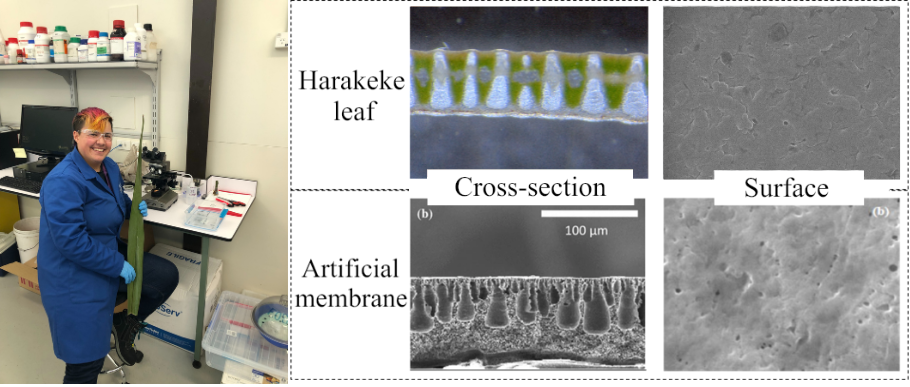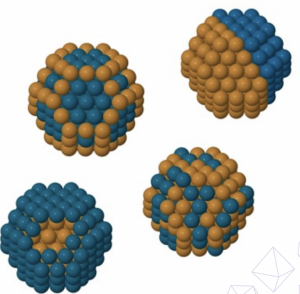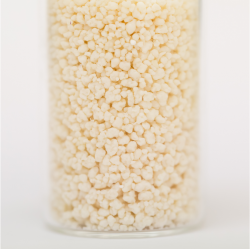Celebrating Matariki values in our research
19 June, 2025

Deputy Director Māori, Dr Pauline Harris
MacDiarmid Institute Deputy Director Māori, Associate Professor Pauline Harris, who was a member of the Government’s Matariki Advisory Committee advising on the new public holiday Matariki, shares with us some of the values and principles of Matariki and how the sustainability research of the MacDiarmid Institute continues to reflect those values.
Dr Harris explains that Matariki is a time of reflection and renewal. This year, we mark Matariki mā Puanga — with some iwi observing the rising of Puanga (Rigel) and others the rising of Matariki (Pleiades) as the beginning of the Māori New Year. Both stars are deeply significant and are part of diverse iwi traditions across Aotearoa.
In 2025, Matariki will be celebrated on Friday 20 June. The national broadcast of the Mānawatia a Matariki ceremony will run from 6:00am to 11:00am at www.matariki.com/live.
Matariki centres on three themes: remembrance – honouring those we have lost since the last rising of Matariki; celebration – gathering together to celebrate together, travelling home with family or gathering with friends and being present; and aspiration – looking ahead to the promise of the year to come.
Dr Harris highlights that many of the values associated with Matariki are rooted in traditional practice and remain vital to modern society. These include Kotahitanga (Unity), Tohatoha (Sharing), Noho tahi (Coming together), Manaakitanga (Caring), Tuakiritanga (Identity), and Mana Taiao (Environmental Awareness). These same values are deeply embedded in the kaupapa of the MacDiarmid Institute.
She notes that Māori traditionally used this time to wānanga — to come together to reflect, plan, and discuss important issues for the year ahead. We encourage all MacDiarmid Institute research groups to follow this example: gather together, take time to connect, discuss what matters, and think intentionally about the future of your work. Whether it be planning collaborative projects, setting goals, or identifying areas for growth, this is a powerful moment to reset and realign.
The sustainability focus of the MacDiarmid Institute aligns very closely with these values by the way the Institute comes together to collaborate, share and research to help solve some of the most pressing environmental problems facing the planet today.
Dr Pauline Harris Deputy Director Māori at the MacDiarmid Institute Massey University
The MacDiarmid Institute’s commitment to sustainability and collaboration closely reflects the values of Matariki. Dr Harris points to several examples of our research in into capturing carbon as well as cleaning up nitrates and other pollutants from the environment. Here we share some of examples of our work.
Partnering with Kia Whitingia
Last year, Dr Harris partnered with Kia Whitingia. Led by Te Reureu Kotahitanga Limited and members of the community, Kia Whitingia is a Māori Energy collective that has installed solar energy systems on five marae and a number of homes in and around Te Reureu Valley. Along with a community battery and a peer-to-peer trading system run by OurEnergy, Kia Whitingia want to provide cheaper energy to homes in their community, addressing issues such as energy hardship, healthy homes and energy literacy.
“It’s really important for Māori to be engaged in the energy sector, creating and owning their own energy, and developing systems that work for them. Kia Whitingia is leading the way in this,” Dr Harris says.
During Matariki we acknowledge the leader of this initiative Graeme Everton (Tūwharetoa and Ngāti Raukawa) who passed away in February last year. Graeme was an innovator, an advocate for Māori rights and interests, and an entrepreneur.
You can see an article on Kia Whitingia published on Stuff.
Developing a harakeke membrane for drinking water purification
PhD student Jaye Barclay (they/them, he/him), from Ngāti Apa and Ngāti Hauiti, is developing a harakeke membrane for drinking water purification.
A polymeric membrane is a thin tissue made from long repeating chains of molecules. Polymeric membranes are widely used for water purification both in Aotearoa and globally. However, these membranes are not biodegradable. The process of manufacturing them is also chemically and energetically intensive, producing significant environmental impacts.
Harakeke (Phormium tenax, New Zealand flax) grows prolifically throughout Aotearoa and is a taonga of great cultural significance to Māori, used for everyday necessities such as clothing, netting, and flooring. Recent examination of the structural properties of the harakeke leaf has revealed that they possess similar qualities to the polymeric membranes widely used for water purification. Jaye, along with Dr Nancy Garrity, Manaaki Whenua, MacDiarmid Institute Investigators Dr Ben Yin, Te Herenga Waka - Victoria University of Wellington (VUW) and Professor David Barker, Waipapa Taumata Rau - University of Auckland, and also with Dr Fiona Stevens McFadden (VUW), is working to develop a membrane for water filtration from the blade of harakeke leaves. This technology would provide an eco-friendly alternative to currently used water filtration membranes, allowing us to purify our water without the added cost to the environment.

Jaye Barclay (they/them, he/him), PhD student, holding a harakeke leaf (LEFT).
Cross section and surfaces of the harakeke leaf versus that of polymeric membranes (RIGHT)
This research project provides a unique and exciting opportunity to conduct research that is grounded in Mātauranga Māori. The transdisciplinary approach to developing this new technology also draws expertise from a diverse range of disciplines within STEM fields and exists at the interface between Eurocentric systems of science and Mātauranga Māori.
This project is part of our Sustainable Resource Use - Pūtaiao Māori Research Programme and relates also to our Towards Zero Waste - Reconfigurable Systems Research Programme. You can read more about Jaye's research in our latest annual report feature on their work
Affiliated start-up companies relating to environmental remediation and climate change
Over the past couple of years, our Investigators have spunout several new affiliated start-up companies that relate to environmental remediation and climate change:
Bspkl, pronounced (bɪˈspɛkəl) was established in 2023 by our former Investigator from GNS Science, Dr Jérôme Leveneur, as co-founder. Bspkl activates sustainability through innovative manufacturing, with their first product being an ultra-low iridium catalyst coated membrane to easy supply chain bottlenecks for the green hydrogen industry.
Captivate Technology is a new (2022) start-up set up by Principal Investigator Professor Shane Telfer, to develop metal-organic-frameworks for carbon dioxide capture to support industries achieve Carbon Zero.
Liquium was set up by Principal Investigator Associate Professor Franck Natali in 2022 to develop new catalyst materials for a greener, cheaper and scalable ammonia production.
Spherelose is an innovative start-up, established in 2024 by Principal Investigator Dr Jack Chen, dedicated to developing cellulose-based surfactants that eliminate the need for traditional petrochemical feedstocks. These surfactants have broad applications in industries such as cosmetics, food production, and agriculture. By leveraging cellulose, Spherelose aims to enhance sustainability and significantly reduce the carbon footprint associated with these products.
Helping to restore a Rotorua water catchment
The MacDiarmid Institute is working with Whakarewarewa Village to support their ambition to restore the Puarenga catchment, alongside local Councils and a number of other contributors.
The catchment feeds the Puarenga Stream that flows through the Village, under the famous penny-diving bridge, and into Lake Rotorua.
Principal Investigator Professor Geoff Willmott, says in recent times a number of agricultural and industrial pollution sources within the catchment have degraded the quality of the stream.
The mātauranga held by our collaborators describes activities such as swimming and collection of kai which are no longer possible
Professor Geoff Willmott Principal Investigator The University of Auckland
“The mātauranga held by our collaborators describes activities such as swimming and collection of kai which are no longer possible, as well as records of the appearance of flora and fauna.”
He says the Institute is assisting Whakarewarewa Village through support for proposals that would fund:
- remediation;
- interpretation and planning based on the available information;
- connections to relevant experts inside and outside of the Institute; and
- planning for collaborative research projects using new ideas.
He says examples of that research could include new monitoring strategies to ‘fingerprint’ the water quality (with MacDiarmid Institute researcher Professor Mark Waterland), and deployment of innovative remediation strategies (MacDiarmid Institute researchers Associate Professor Robin Fulton and Professor David Barker).
Capturing carbon dioxide
One key area of research in our Catalytic Architectures Research Programme studies new materials that can capture carbon dioxide. A new class of porous materials, called metal-organic frameworks (MOFs), is able to sieve out carbon dioxide from gas streams. The carbon dioxide can then be easily desorbed (or released) from the material, and the MOF materials recycled for another round of carbon capture.
Professor Shane Telfer, former leader of the Institute's Zero Carbon Research Programme, says that the Institute’s research is focusing both on the capture of carbon and using it as a feedstock for valuable products such as fuels and polymers and other things we use every day.
The idea is to turn this carbon capture process into a cyclic system – like a circular economy.
Professor Shane Telfer Principal Investigator Massey University
“The idea is to turn this carbon capture process into a cyclic system – like a circular economy. There is the potential to combine carbon dioxide with green hydrogen to make methanol or to use electrochemistry to convert it to other compounds.”
He acknowledges that there is a big challenge to scale up production of the new materials, and that new engineering systems will need to be deployed so the materials can be effective on a large scale.
“But in the meantime, carbon capture is one part of the whole equation and one of many pillars (along with tree planting, geochemical storage and changing our agricultural processes) that we need to simultaneously deploy to meet the challenge of climate change.”
(You can hear Professor Telfer speak further about this on TodayFM)
Using computational modelling to help solve New Zealand’s nitrate problem
Associate Professor Anna Garden, a researcher in our Zero Carbon Programme, is designing new catalysts that could selectively convert the nitrate pollutants in water into harmless nitrogen gas.
A theoretical chemist, Dr Garden uses modelling to ‘try out’ different elements and shapes for the catalysts, working to reduce the toxicity of potential additives.
“We don’t want to put more hazardous material into the environment in order to ‘clean it up’”, she says. “So experimenting theoretically can help us rule out toxic ones and helps lab researchers to focus on those that will be both most effective and least polluting.”
Dr Garden experiments theoretically with nanoparticle sized catalysts, which she says are important because they use far less material than bulk catalysts, and they also come in many different shapes, which, she says, can lead to really interesting reactivity.
“The edges and corners on nanoparticle catalysts are often highly reactive. These different sites can drive reactions in different ways, either towards desired products, such as nitrogen gas, or undesired by-products.”
Modelling these on a computer can reveal what types of nanoparticles lead to the desired products while minimising harmful products. This would take months or years of an experimental-lab scientist’s time.
“The computational approach gives a level of control over conditions that would be really hard to get experimentally. So you can investigate precise shapes and compositions of likely catalysts, and carefully understand all the variables, which can be challenging in the lab.”
You can read more about Dr Garden’s work here.
Cleaning up ‘forever chemicals’
Reconfigurable Systems Research Programme member, Dr Jack Chen, is investigating the removal of perfluoroalkylated substances (PFAS) from contaminated water.
Perfluoroalkylated substances (PFAS) are synthetic chemicals made by joining carbon and fluorine atoms together. They possess unique properties such as the ability to repel both oil and water. Common products where PFAS are found include household furnishings, electronics, Gore-Tex jackets and the Teflon on non-stick fry pans.

Polymer beads for selective removal of PFAS from contaminated water
The World Health Organisation defines PFAS as ‘highly resistant persistent compounds used for repelling oil, grease and water and protecting the surfaces of carpets and clothing; they are also found in fire-fighting foams.’ It says PFAS ‘have negative consequences for human health, although these are not fully established.’ Specific members of the PFAS family of compounds have been shown to be hazardous to human health, but since the PFAS family of compounds consists of thousands of compounds, progress on determining the risks of each compound has been slow.
PFAS are known as ‘forever chemicals’ as they don’t break down in the environment. They have also been found to bioaccumulate in wildlife.
Dr Chen says it’s hard to say how much is in New Zealand because there hasn’t been enough research done.
We don’t produce any PFAS in New Zealand, but we do import them and use them in several industries.
Dr Jack Chen Associate Investigator Auckland University of Technology
“We don’t produce any PFAS in New Zealand, but we do import them and use them in several industries. Another issue is that the current ‘disposal’ methods for PFAS involves either burying in landfill or shipping overseas for high-temperature incineration.”
Dr Chen is helping Amaea, a Hamilton company, develop technology to remove PFAS from water.
“We are working with Amaea to develop polymers that can selectively absorb PFAS and remove them out of contaminated water. The technology would be used to treat wastewater effluent from a company that might use PFAS. Once removed from water, we will explore non-incineration methods to breakdown PFAS into non-toxic products.”


